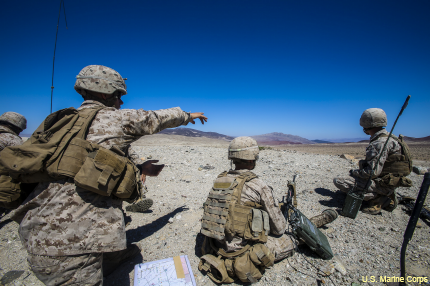The military is becoming immersed in virtual training
As simulations become more realistic and scalable, the services are putting them to use in large-scale exercises.

Marines combined live exercises and simulators in ground and air operations during Large Scale Exercise 2014.
Military leaders are looking to make even greater use of large-scale immersive simulations in training exercises, as the quality of those simulations continues to improve.
Simulations have always had advantages in cost and safety over live training, but the immersive systems today can also make warfighters familiar with environments—even people—they might encounter, before they ever encounter them.
“Virtual training bridges the gap between classroom and live training,” Brig. Gen. Joseph Shrader, commander of Marine Corps Systems Command, said at a recent conference in Orlando, Fla., according to a Marine posting. Schrader and military leaders spoke during a panel discussion at the Interservice/Industry Training, Simulation and Education Conference Dec. 2.
One example cited during the panel was the Large Scale Exercise 2014 in August, which combined live training with virtual and constructive simulation to create a common scenario for participants at separate locations. The exercise included Marines both on the ground and in simulators at Twentynine Palms, Calif., flight simulators in Yuma, Ariz., and command and control being handled as far away as Marine Corps Base Quantico, Va.
The exercise involved what’s called live, virtual and constructive, or LVC, training and showed that LVC could be successful when used in exercises involving far-flung participants and both ground and air forces. And the immersive quality has real advantages.
“The biggest thing I take away—from the ground perspective—is that Marines can use their ‘green’ gear—the gear they were issued—and plug into [the virtual systems],” Shrader said. “Instead of putting on a pair of virtual glasses and stepping into a virtual world and training [only] that way, these systems allow Marines to plug into the system and use the gear they’re going to fight with. There’s a lot of goodness in that.”
Truly immersive simulations are the next frontier for training platforms being developed by the services, such as the Army’s Live Synthetic program, which also combines live field exercises with simulations built on the Army’s Live Virtual Constructive-Integrative Architecture, or LVC-IA.
And researchers are always working on making them more realistic. In the fall issue of the Navy’s Future Force magazine (PDF), a team of researchers write about one example—introducing a more human element to the “people,” or surrogates, encountered in a simulation. They note that while simulating a machine is pretty easy—flight simulators have gotten so good that in some cases a pilot can gain certification entirely on work done in a simulator—making a virtual person, or surrogate, poses a new challenge.
Even realistic-looking surrogates lack the cognitive functions of humans. As a result, participants don’t treat them as human, “but as tasks or games that must be mastered via a formulaic interaction,” the authors write. One possible solution being worked on at the University of Southern California, with support from the Office of Naval Research and the Army, is using human surrogates, or avatars, performing their roles remotely. That approach presents its own challenges, but it offers an idea of what could come next in virtual training.
Meanwhile, the Defense Department is working on a broad plan for live and synthetic training across DOD, involving academia and industry along with the services, Frank DiGiovanni, acting deputy assistant secretary of Defense for Readiness, said at the Orlando conference.
Part of that plan could include making virtual training mandatory. Right now, unit commanders make the call on how much virtual training is used, but Shrader suggested that a certain amount be made mandatory.
Army Col. David Cannon, capability manager for U.S. Army Training and Doctrine Command, agreed with its benefits. “We need to get our soldiers prepared to operate and thrive in chaos and ambiguity,” he said. “With [virtual training] we have the ability to train in an environment that’s immersive. We have to understand that the world has changed and we have to train for those changes.”




